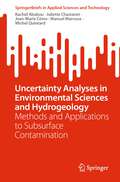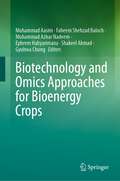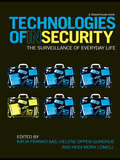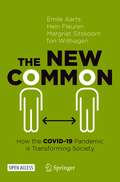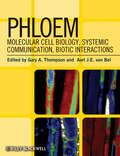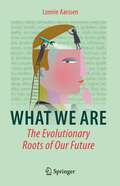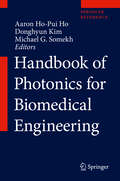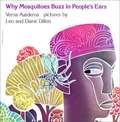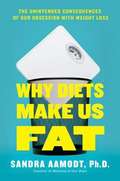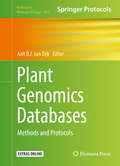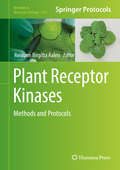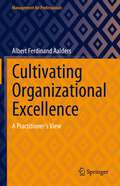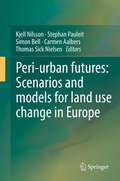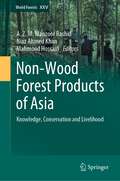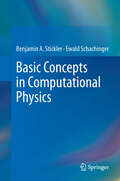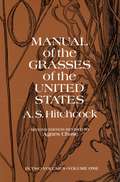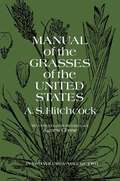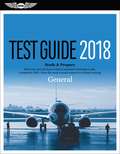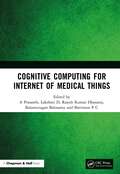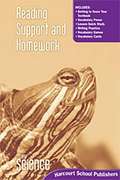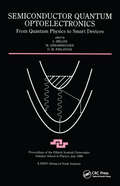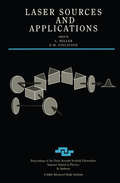- Table View
- List View
Uncertainty Analyses in Environmental Sciences and Hydrogeology: Methods and Applications to Subsurface Contamination (SpringerBriefs in Applied Sciences and Technology)
by Rachid Ababou Juliette Chastanet Jean-Marie Côme Manuel Marcoux Michel QuintardThis book highlights several methods and quantitative implementations of both probabilistic and fuzzy-based approaches to uncertainty quantification and uncertainty propagation through environmental subsurface pollution models with uncertain input parameters. The book focuses on methods as well as applications in hydrogeology, soil hydrology, groundwater contamination, and related areas (e.g., corrosion of nuclear waste canisters). The methods are illustrated for a broad spectrum of models, from non-differential I/O models to complex PDE solvers, including a novel 3D quasi-analytical model of contaminant transport, and a site-specific computer model of dissolved contaminant migration from a DNAPL (Dense Non Aqueous Phase Liquid) pollution source.
Biotechnology and Omics Approaches for Bioenergy Crops
by Muhammad Aasim Faheem Shehzad Baloch Muhammad Azhar Nadeem Ephrem Habyarimana Shakeel Ahmad Gyuhwa ChungThis edited book summarizes the efforts made to develop sustainable bioenergy production through different generations. The topics included in the book cover information about different bioenergy crops, their classification and use as biofuel, agronomic practices to improve biomass yield, classic breeding techniques, genetic diversity, current status and future perspective of bioenergy crops in the omics era. It also discusses application of modern biotechnological and molecular biotechnological techniques for the improvement of bioenergy crops this having enhanced biomass and plant based products. The book explores growing biofuel crops and their impact on environment, bioethics and biosafety issues related to the modern approaches. Another important aspect is the incorporation of nanotechnology for bioenergy crops and biofuel production. All book chapters are contributed renowned researchers in their respective field. This is a unique book covering the bioeneragy crops in the modern omics era. The book is useful for the researchers and post-graduate students to guide them in the field of bioenergy crops.
Technologies of InSecurity: The Surveillance of Everyday Life
by Katja Aas Helene Gundhus Heidi LomellTechnologies of Insecurity examines how general social and political concerns about terrorism, crime, migration and globalization are translated into concrete practices of securitisation of everyday life. Who are we afraid of in a globalizing world? How are issues of safety and security constructed and addressed by various local actors and embodied in a variety of surveillance systems? Examining how various forms of contemporary insecurity are translated into, and reduced to, issues of surveillance and social control, this book explores a variety of practical and cultural aspects of technological control, as well as the discourses about safety and security surrounding them. (In)security is a politically and socially constructed phenomenon, with a variety of meanings and modalities. And, exploring the inherent duality and dialectics between our striving for security and the simultaneous production of insecurity, Technologies of Insecurity considers how mundane objects and activities are becoming bearers of risks which need to be neutralised. As ordinary arenas - such as the workplace, the city centre, the football stadium, the airport, and the internet - are imbued with various notions of risk and danger and subject to changing public attitudes and sensibilities, the critical deconstruction of the nexus between everyday surveillance and (in)security pursued here provides important new insights about how broader political issues are translated into concrete and local practices of social control and exclusion.
The New Common: How the COVID-19 Pandemic is Transforming Society
by Emile Aarts Hein Fleuren Margriet Sitskoorn Ton WilthagenThis open access book presents the scientific views of some fifty experts on how they believe the COVID-19 pandemic is currently affecting society, and how it will continue to do so in the years to come. Using the concept of a “common” (in the sense of common values, common places, common goods, and common sense), they elaborate on the transition from an Old Common to a New Common. In carefully crafted chapters, the authors address expected shifts in major fields like health, education, finance, business, work, and citizenship, applying concepts from law, psychology, economics, sociology, religious studies, and computer science to do so. Many of the authors anticipate an acceleration of the digital transformation in the forthcoming years, but at the same time, they argue that a successful shift to a new common can only be achieved by re-evaluating life on our planet, strengthening resilience at an individual level, and assuming more responsibility at a societal level.
Phloem
by Aart J.E. van Bel Gary A. ThompsonPhloem: Molecular Cell Biology, Systemic Communication, Biotic Interactions is a timely collection of research on the cellular and molecular biology of this plant vascular tissue. Recent advances in phloem research have revealed the centrality of this plant tissue to whole plant development and physiology. Building on advances made through developments of new analytical technologies, this book will provide readers with a current and comprehensive reference on the role of phloem in plant growth and development. Collecting the work of a global team of leading researchers, Phloem will provide the reader with a valuable synthesis of the latest research in a single volume.
What We Are: The Evolutionary Roots of Our Future
by Lonnie AarssenOther animals are driven to spend essentially their whole lives just trying to get fed, stay alive, and get laid. That’s about it. The same was true for our proto-human ancestors. And modern humans of course also require a Survival Drive and a Sex Drive in order to leave descendants. But today we spend most of our lives mainly just trying to convince ourselves that our existence is not absurd. In What We Are, Queen’s University biologist, Lonnie Aarssen, traces how our biocultural evolution has shaped Homo sapiens into the only creature that refuses to be what it is — the only creature preoccupied with a deeply ingrained, and absurd sentiment: I have a distinct ‘mental life’—an ‘inner self’—that exists separately and apart from ‘material life’, and so, unlike the latter, need not come to an end. This delusion conceivably gave our distant ancestors some wishful thinking for finding some measure of relief from the terrifying, uniquely human knowledge of the eventual loss of corporeal survival. But this came with an impulsive, nagging doubt — an obsessive underlying uncertainty: ‘self-impermanence anxiety’. Biocultural evolution, however, was not finished. It also gave us two additional, uniquely human, primal drives, both serving to help quell the burden of this anxiety. Legacy Drive generates delusional cultural domains for ‘extension’ of self; and Leisure Drive generates pleasurable cultural domains for distraction – ‘escape’ – from self. Legacy Drive and Leisure Drive, Aarssen argues, represent two of the most profound consequences of human cognitive and cultural evolution. What We Are advances propositions regarding how a visceral susceptibility to self-impermanence anxiety has — paradoxically — played a pivotal role in rewarding the reproductive success of our ancestors, and has thus been a driving force in shaping fundamental motivations and cultural norms of modern humans. More than any other milestone in the evolution of human minds, self-impermanence anxiety, and its mitigating Drives for Legacy and Leisure, account for not just the advance of civilization over the past many thousands of years, but also now, its impending collapse. Effective management of this crisis, Aarssen insists, will require a deeper and more broadly public understanding of its Darwinian evolutionary roots — as laid out in What We Are.
Quantum Computing since Democritus
by Scott AaronsonWritten by noted quantum computing theorist Scott Aaronson, this book takes readers on a tour through some of the deepest ideas of maths, computer science and physics. Full of insights, arguments and philosophical perspectives, the book covers an amazing array of topics. Beginning in antiquity with Democritus, it progresses through logic and set theory, computability and complexity theory, quantum computing, cryptography, the information content of quantum states and the interpretation of quantum mechanics. There are also extended discussions about time travel, Newcomb's Paradox, the anthropic principle and the views of Roger Penrose. Aaronson's informal style makes this fascinating book accessible to readers with scientific backgrounds, as well as students and researchers working in physics, computer science, mathematics and philosophy.
Handbook of Photonics for Biomedical Engineering
by Aaron Ho-Pui Ho Donghyun Kim Michael G. SomekhNanophotonics has emerged rapidly into technological mainstream with the advent and maturity of nanotechnology available in photonics and enabled many new exciting applications in the area of biomedical science and engineering that were unimagined even a few years ago with conventional photonic engineering techniques. Handbook of Nanophotonics in Biomedical Engineering is intended to be a reliable resource to a wealth of information on nanophotonics that can inspire readers by detailing emerging and established possibilities of nanophotonics in biomedical science and engineering applications. This comprehensive reference presents not only the basics of nanophotonics but also explores recent experimental and clinical methods used in biomedical and bioengineering research. Each peer-reviewed chapter of this book discusses fundamental aspects and materials/fabrication issues of nanophotonics, as well as applications in interfaces, cell, tissue, animal studies, and clinical engineering. The organization provides quick access to current issues and trends of nanophotonic applications in biomedical engineering. All students and professionals in applied sciences, materials, biomedical engineering, and medical and healthcare industry will find this essential reference book highly useful.
Why Mosquitoes Buzz in People’s Ears: A West African Tale
by Verna Aardema Leo Dillon Diane DillonNIMAC-sourced textbook
Why Diets Make Us Fat: The Unintended Consequences of Our Obsession With Weight Loss
by Sandra Aamodt"If diets worked, we'd all be thin by now. Instead, we have enlisted hundreds of millions of people into a war we can't win." What's the secret to losing weight? If you're like most of us, you've tried cutting calories, sipping weird smoothies, avoiding fats, and swapping out sugar for Splenda. The real secret is that all of those things are likely to make you weigh more in a few years, not less. In fact, a good predictor of who will gain weight is who says they plan to lose some. Last year, 108 million Americans went on diets, to the applause of doctors, family, and friends. But long-term studies of dieters consistently find that they're more likely to end up gaining weight in the next two to fifteen years than people who don't diet. Neuroscientist Sandra Aamodt spent three decades in her own punishing cycle of starving and regaining before turning her scientific eye to the research on weight and health. What she found defies the conventional wisdom about dieting: ·Telling children that they're overweight makes them more likely to gain weight over the next few years. Weight shaming has the same effect on adults. ·The calories you absorb from a slice of pizza depend on your genes and on your gut bacteria. So does the number of calories you're burning right now. ·Most people who lose a lot of weight suffer from obsessive thoughts, binge eating, depression, and anxiety. They also burn less energy and find eating much more rewarding than it was before they lost weight. ·Fighting against your body's set point--a central tenet of most diet plans--is exhausting, psychologically damaging, and ultimately counterproductive. If dieting makes us fat, what should we do instead to stay healthy and reduce the risks of diabetes, heart disease, and other obesity-related conditions? With clarity and candor, Aamodt makes a spirited case for abandoning diets in favor of behaviors that will truly improve and extend our lives.From the Hardcover edition.
Plant Genomics Databases
by Aalt D.J van DijkThis volume introduces databases containing the results from the recent revolution in sequencing technologies. Chapters in Plant Genomics Databases: Methods and Protocols describe database content, as well as typical use-cases. Some chapters explore databases that primarily present genome sequences focusing on one or a few related species, while others include additional datatypes and/or data from various plant species. Written in the highly successful Methods in Molecular Biology series format, chapters include introductions to their respective topics, step-by-step, readily reproducible protocols, and tips on troubleshooting and avoiding known pitfalls.Cutting-edge and comprehensive, Plant Genomics Databases: Methods and Protocols is a valuable resource for providing clear guidance in accessing an important collection of plant databases that can be used to add biological value to genomic data.
Plant Receptor Kinases
by Reidunn Birgitta AalenThis is volume presents protocols relevant for plant receptor kinases(PRK) both in development and defence. Chapters guide readers through comprehensive experimental approach for molecular investigations of plant receptor kinases, from the simplest methods for expression and purification of receptor domains to the most advanced methods aiming at understanding the dynamics of receptor complex formation and specificity of signaling pathways. Written in the highly successful Methods in Molecular Biology series format, chapters include introductions to their respective topics, lists of the necessary materials and reagents, step-by-step, readily reproducible laboratory protocols, and tips on troubleshooting and avoiding known pitfalls. Authoritative and practical, Plant Receptor Kinases: Methods and Protocols aims to ensure successful results in the further study of this vital field.
Cultivating Organizational Excellence: A Practitioner’s View (Management for Professionals)
by Albert Ferdinand AaldersThis book offers a comprehensive approach to organizational excellence based on the author’s vast experience in managing excellence at highly innovative and dynamic organizations. It integrates various approaches into a consistent view of achieving excellence in the context of dynamic technological and societal developments. Starting from purpose and mission, it describes stakeholder mapping and analysis, and process and quality management. In turn, it sheds light on how to deal with business dynamics of various types and demonstrates how quantum-mechanical models can help to understand and manage dynamic organizational processes. The book then introduces readers to result measuring and performance management, followed by organizational learning and rewards and recognition. Moreover, it discusses (innovation) ecosystem leverage and organizational culture management as further important capabilities of excellent organizations. Best practices in corporate social responsibility and environmental, social and governance aspects are fully integrated throughout the book, which concludes by explaining how the UN Sustainable Development Goals can be applied to optimize business initiatives. The book is intended as a source of inspiration for managers working under highly dynamic organizational conditions, helping them take their businesses to higher levels. It also provides valuable industrial insights for scholars with an interest in organizational excellence.
Peri-urban futures: Scenarios and models for land use change in Europe
by Carmen Aalbers Kjell Nilsson Simon Bell Stephan Pauleit Thomas A. Sick NielsenPresently, peri-urbanisation is one of the most pervasive processes of land use change in Europe with strong impacts on both the environment and quality of life. It is a matter of great urgency to determine strategies and tools in support of sustainable development. The book synthesizes the results of PLUREL, a large European Commission funded research project (2007-2010). Tools and strategies of PLUREL address main challenges of managing land use in peri-urban areas. These results are presented and illustrated by means of 7 case studies which are at the core of the book. This volume presents a novel, future oriented approach to the planning and management of peri-urban areas with a main focus on scenarios and sustainability impact analysis. The research is unique in that it focuses on the future by linking quantitative scenario modeling and sustainability impact analysis with qualitative and in-depth analysis of regional strategies, as well as including a study at European level with case study work also involving a Chinese case study.
Non-Wood Forest Products of Asia: Knowledge, Conservation and Livelihood (World Forests #25)
by A. Z. M. Manzoor Rashid Niaz Ahmed Khan Mahmood HossainThis book highlights the importance of non-wood forest products (NWFPs) and their crucial role in sustaining the livelihood of rural and indigenous communities in Asia. The authors depict how the preservation of forests and the associated major non-wood resources may provide an important avenue to reduce poverty. The local practices and knowledge on harvesting NWFPs are often rooted in tradition, and vary from one region to the other. This made it difficult to develop and establish research focus on a greater scale in the past. Readers of this volume will gain an often-missed, broader perspective from these new studies. The authors put a special emphasis on the nexus between conservation and livelihood from an Asian point of view. This addresses a knowledge gap in the current literature and offers important clues on conducting similar research around the world. The volume provides a useful reference guide for the relevant researchers, practitioners and policy makers.
Basic Concepts in Computational Physics
by Benjamin A. Stickler Ewald SchachingerWith the development of ever more powerful computers a new branch of physics and engineering evolved over the last few decades: Computer Simulation or Computational Physics. It serves two main purposes:- Solution of complex mathematical problems such as, differential equations, minimization/optimization, or high-dimensional sums/integrals.- Direct simulation of physical processes, as for instance, molecular dynamics or Monte-Carlo simulation of physical/chemical/technical processes.Consequently, the book is divided into two main parts: Deterministic methods and stochastic methods. Based on concrete problems, the first part discusses numerical differentiation and integration, and the treatment of ordinary differential equations. This is augmented by notes on the numerics of partial differential equations. The second part discusses the generation of random numbers, summarizes the basics of stochastics which is then followed by the introduction of various Monte-Carlo (MC) methods. Specific emphasis is on MARKOV chain MC algorithms. All this is again augmented by numerous applications from physics. The final two chapters on Data Analysis and Stochastic Optimization share the two main topics as a common denominator. The book offers a number of appendices to provide the reader with more detailed information on various topics discussed in the main part. Nevertheless, the reader should be familiar with the most important concepts of statistics and probability theory albeit two appendices have been dedicated to provide a rudimentary discussion.
Manual of the Grasses of the United States, Volume One
by A. S. U.S. Dept. of Agriculture A. S. HitchcockThis work is actually the definitive encyclopedia of United States grass life. Compiled from the U.S. National Herbarium collection, the largest of its kind in the world, it is the only complete manual of U.S. grasses available and one of the basic reference works on U.S. plant life. It catalogs and describes in detail all 1,398 numbered species in 169 numbered genera found in this country, plus 120 species in 16 genera of the so-called “waifs.” Professor Hitchcock is the former Chief Botanist in charge of systematic agrostology for the U.S. Department of Agriculture, by whom the work was originally published, and an internationally known authority.The heart of the book is its detailed descriptions of the family of grasses, the two main subfamilies, the tribes, genera, and species. Quick finding keys are provided for the identification of tribes and genera. Each of the species is given thorough botanical description, including various aspects of its morphology — size, shape, form of culms, blades, panicles, spikes, and flowers — and height, proper planting season, and range of distribution are noted. The Manual also outlines the common uses to which grasses are put and discusses in general terms their distribution, classification, nomenclature, and common names. The 1,199 drawings make identification of any grass species found in the United States a virtual certainty. The appended synonymy of alternate names for each species provides an authoritative taxonomy, eliminating confusion.The nature lover with no more technical equipment than a keen eye can use this manual with profit, for a glossary of botanical terms is included. Naturalists, botanists, agriculturists, and horticulturists will find it valuable as a field and research guide to virtually all the grasses that grow in this country.
Manual of the Grasses of the United States, Volume Two
by A. S. U.S. Dept. of Agriculture A. S. HitchcockThis work is actually the definitive encyclopedia of United States grass life. Compiled from the U.S. National Herbarium collection, the largest of its kind in the world, it is the only complete manual of U.S. grasses available and one of the basic reference works on U.S. plant life. It catalogs and describes in detail all 1,398 numbered species in 169 numbered genera found in this country, plus 120 species in 16 genera of the so-called “waifs.” Professor Hitchcock is the former Chief Botanist in charge of systematic agrostology for the U.S. Department of Agriculture, by whom the work was originally published, and an internationally known authority.The heart of the book is its detailed descriptions of the family of grasses, the two main subfamilies, the tribes, genera, and species. Quick finding keys are provided for the identification of tribes and genera. Each of the species is given thorough botanical description, including various aspects of its morphology — size, shape, form of culms, blades, panicles, spikes, and flowers — and height, proper planting season, and range of distribution are noted. The Manual also outlines the common uses to which grasses are put and discusses in general terms their distribution, classification, nomenclature, and common names. The 1,199 drawings make identification of any grass species found in the United States a virtual certainty. The appended synonymy of alternate names for each species provides an authoritative taxonomy, eliminating confusion.The nature lover with no more technical equipment than a keen eye can use this manual with profit, for a glossary of botanical terms is included. Naturalists, botanists, agriculturists, and horticulturists will find it valuable as a field and research guide to virtually all the grasses that grow in this country.
General Test Guide 2018: Pass Your Test And Know What Is Essential To Become A Safe, Competent Amt From The Most Trusted Source In Aviation Training
by A. S. A. Test ASA Test Prep BoardThe Fast Track Series is designed to prepare applicants who are seeking Federal Aviation Administration (FAA) certifications for the full range of material on each test of the series. Prospective test takers are supplied with questions that have been used in the FAA's knowledge exams for aviation mechanics along with an answer key, explanations, and references to quickly improve their comprehension and retention of the test and study materials. Learning Statement Codes (LSC) are also included, enabling students to easily interpret which subject areas are indicated as needing further study on their knowledge test reports. This volume of the series deals with the "General" section of the FAA Knowledge Requirements for Aviation Maintenance Technicians.
Chemcom Chemistry in the Community (Third Edition)
by A Project of the American Chemical SocietyAn introductory chemistry lab book for high school students.
Chemcom Chemistry in the Community (Third Edition): Chemistry In The Community; A Project Of The American Chemical
by A Project of the American Chemical SocietyAn introductory chemistry lab book for high school students.
Cognitive Computing for Internet of Medical Things
by A. Prasanth, D. Lakshmi, Rajesh Kumar Dhanaraj, Balamurugan Balusamy, P.C. SherimonCognitive Computing for Internet of Medical Things (IoMT) offers a complete assessment of the present scenario, role, challenges, technologies, and impact of IoMT-enabled smart healthcare systems. It contains chapters discussing various biomedical applications under the umbrella of the IoMT. Key Features Exploits the different prospects of cognitive computing techniques for the IoMT and smart healthcare applications Addresses the significance of IoMT and cognitive computing in the evolution of intelligent medical systems for biomedical applications Describes the different computing techniques of cognitive intelligent systems from a practical point of view: solving common life problems Explores the technologies and tools to utilize IoMT for the transformation and growth of healthcare systems Focuses on the economic, social, and environmental impact of IoMT-enabled smart healthcare systems This book is primarily aimed at graduates, researchers and academicians working in the area of development of the application of the of the application of the IoT in smart healthcare. Industry professionals will also find this book helpful.
Semiconductor Quantum Optoelectronics: From Quantum Physics to Smart Devices (Scottish Graduate Ser. #50)
by A Miller; M Ebrahimzadeh; D M FinlaysonThe development and application of low-dimensional semiconductors have been rapid and spectacular during the past decade. Ever improving epitaxial growth and device fabrication techniques have allowed access to some remarkable new physics in quantum confined structures while a plethora of new devices has emerged. The field of optoelectronics in particular has benefited from these advances both in terms of improved performance and the invention of fundamentally new types of device, at a time when the use of optics and lasers in telecommunications, broadcasting, the Internet, signal processing, and computing has been rapidly expanding. An appreciation of the physics of quantum and dynamic electronic processes in confined structures is key to the understanding of many of the latest devices and their continued development.Semiconductor Quantum Optoelectronics covers new physics and the latest device developments in low-dimensional semiconductors. It allows those who already have some familiarity with semiconductor physics and devices to broaden and expand their knowledge into new and expanding topics in low-dimensional semiconductors. The book provides pedagogical coverage of selected areas of new and pertinent physics of low-dimensional structures and presents some optoelectronic devices presently under development. Coverage includes material and band structure issues and the physics of ultrafast, nonlinear, coherent, intersubband, and intracavity phenomena. The book emphasizes various devices, including quantum wells, visible, quantum cascade, and mode-locked lasers; microcavity LEDs and VCSELs; and detectors and logic elements. An underlying theme is high-speed phenomena and devices for increased system bandwidths.
Laser Sources and Applications (Scottish Graduate Ser.)
by A Miller; D M Finlayson; P OsborneRecent years have witnessed rapid advances in the development of solid state, fiber, semiconductor, and parametric sources of coherent radiation, which are opening up new opportunities for laser applications. Laser Sources and Applications provides a tutorial introduction to the basic principles of these developments at a level suitable for postgraduate research students and others with a basic knowledge of lasers and nonlinear optics. Encompassing both the physics and engineering aspects of the field, the book covers the nature of nonlinear optical interactions; solid state, fiber, and semiconductor lasers; optical parametric oscillators; and ultrashort pulse generation and applications. It also explores applications of current interest, such as electromagnetically induced transparency, atomic trapping, and soliton optical communications.
